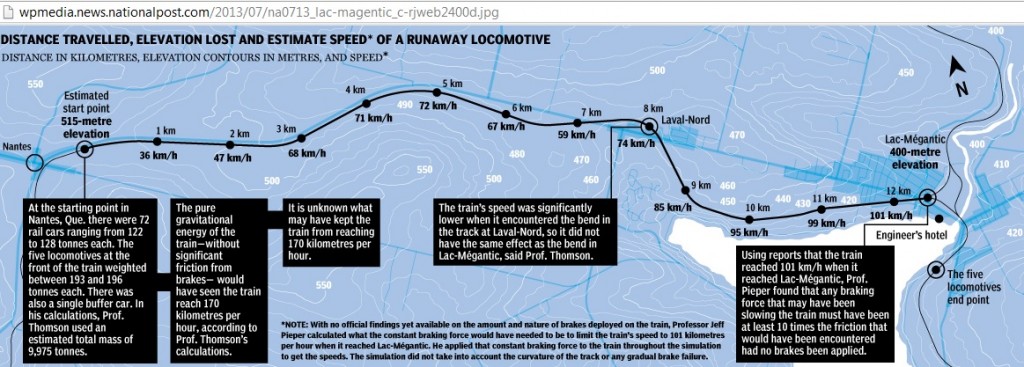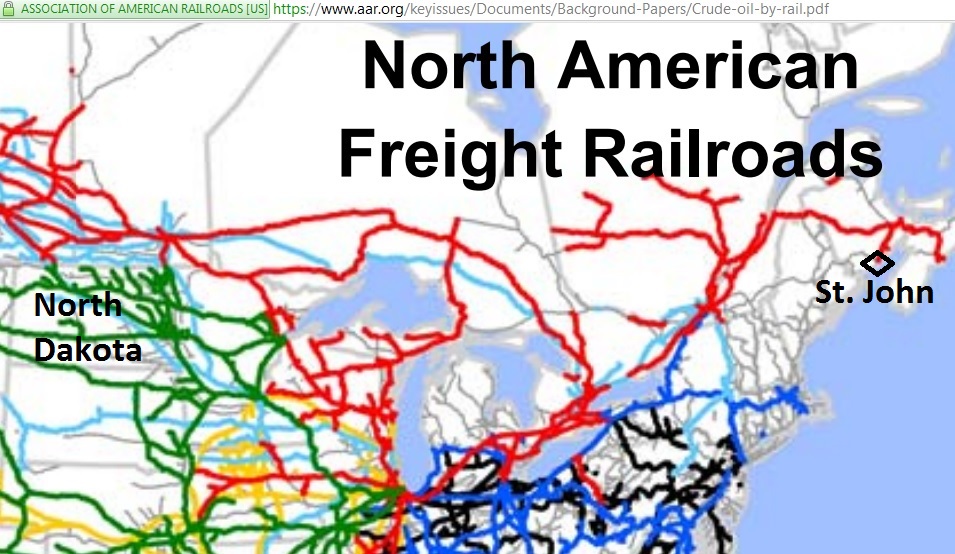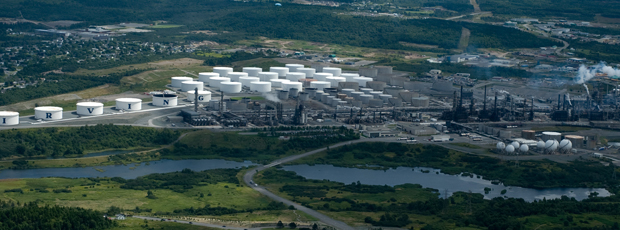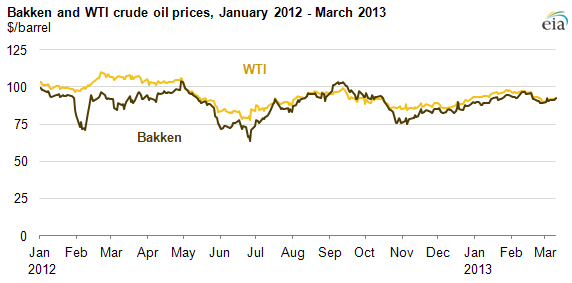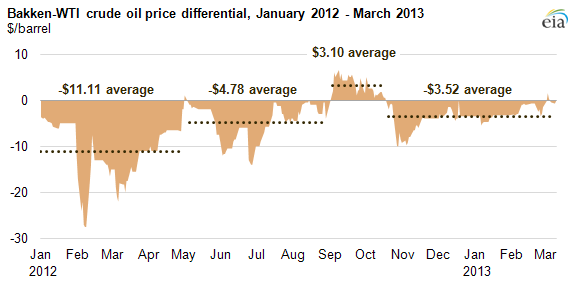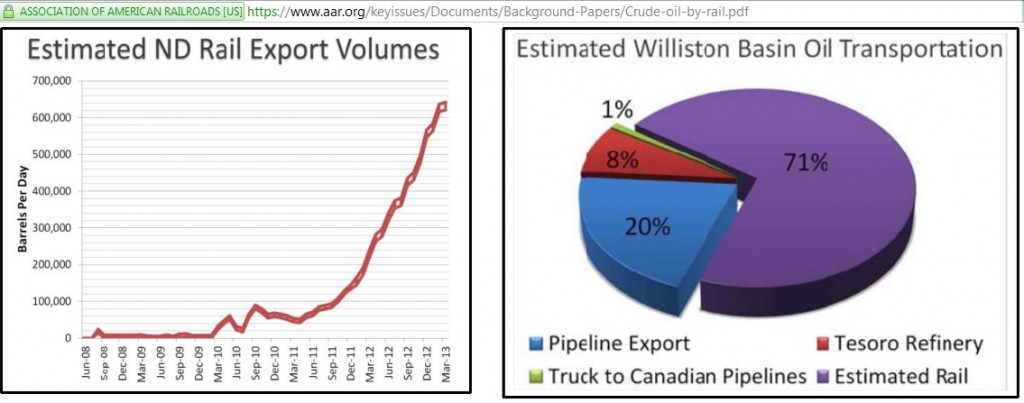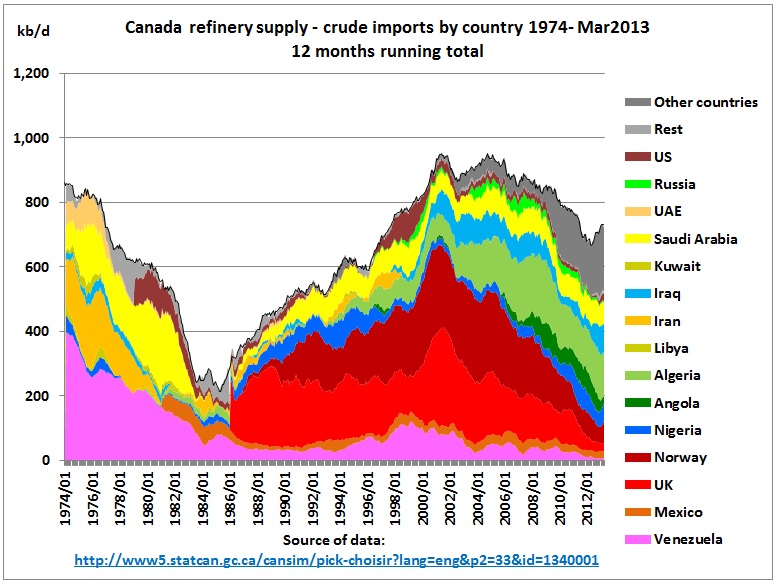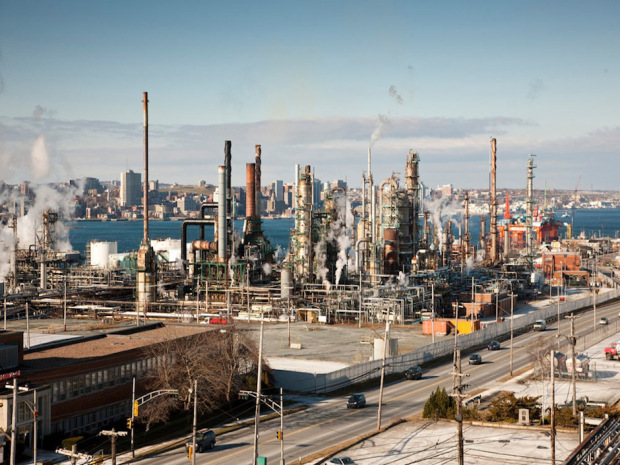The derailment and explosion of a shale oil train in Canada highlights desperate attempts by refineries along the US/Canada East coast to offset the conventional oil peak of Atlantic basin producers who traditionally supplied them with Brent type crude.
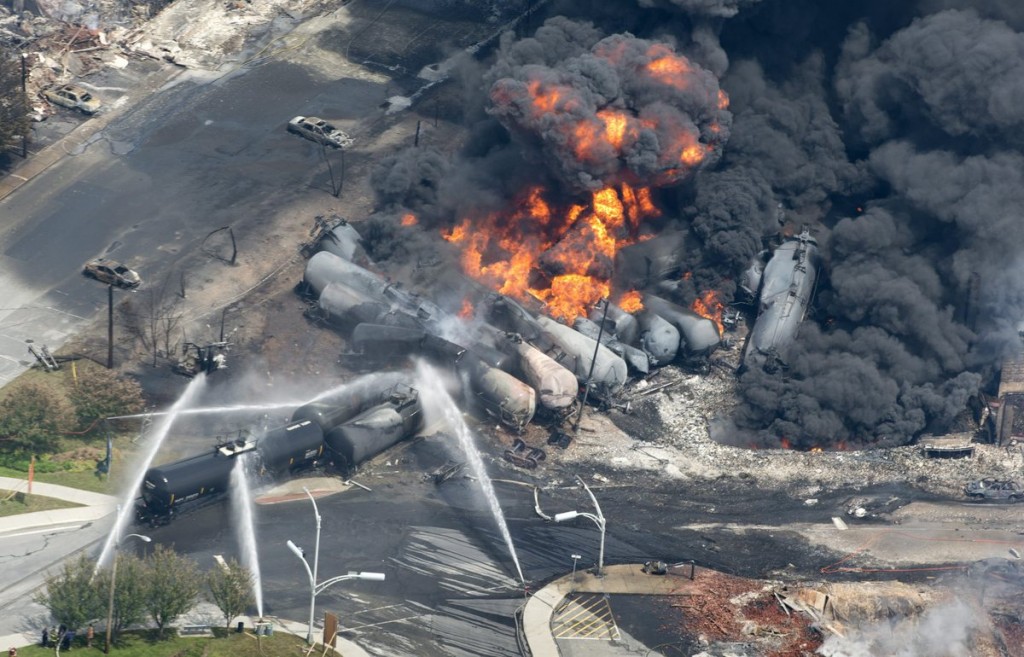
A run-away crude oil train travelling at 100 km/h derailed at a bend in the small Canadian town of Lac Megantic and burst into flames, destroying part of the town centre and killing many people.
The train with 72 cars and 5 locos was left at Nantes for a change of crew at 11:25 pm. Total volume of oil: around 50 Kb.
The rail siding at Nantes. A fire broke out in one of the locos but was extinguished by fire fighters. An hour later, the train starts to move down a 1.2% grade to Lac Megantic, 12 kms away
Mapping the tragedy: A timeline of the Lac Megantic train disaster
The train had come on a 3,200 km long trip from the Bakken oil field in North Dakota with its planned destination the Irving refinery in St. John.
.

Destined for the Irving refinery at Saint John N.B, a Montreal Maine & Atlantic crude oil train idles at Farnham. A new crew will take over for the next 140 miles run to Megantic
..
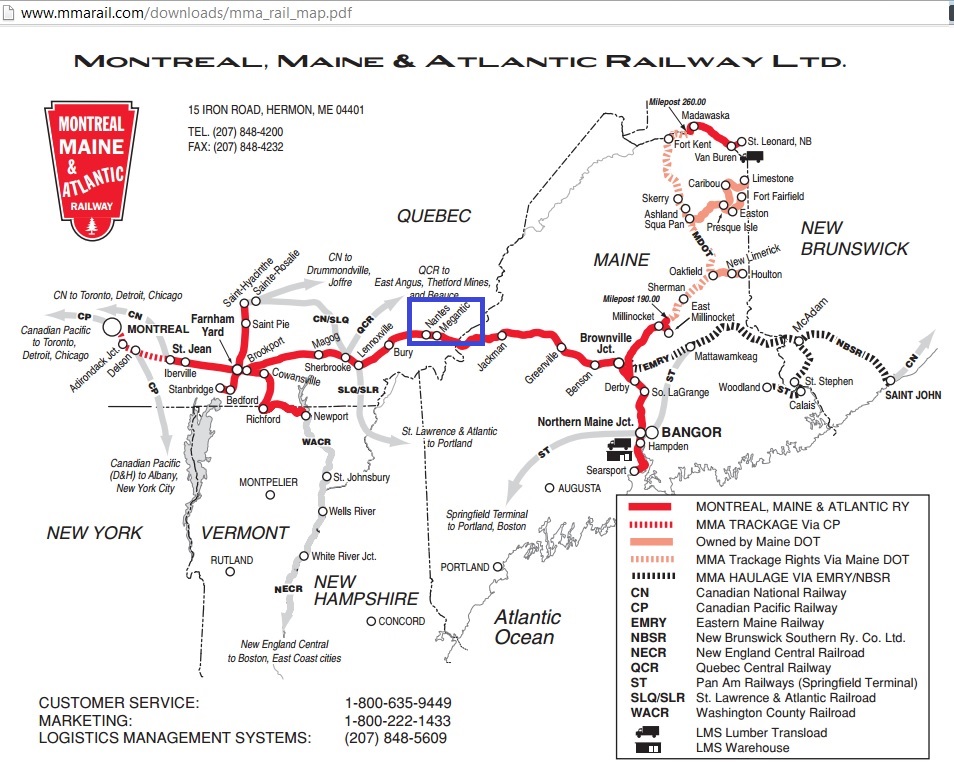
The last leg of the trip from Montreal to St John on the Atlantic via Maine
That’s where the oil came from:

The oil & gas industry sells this as “small footprint”
Desperate times: trucks delivering oil to the loading terminal
Loadout terminal West of Dickinson, North Dakota
.

Idyllic, peaceful town Lac Megantic (French speaking Quebec province)
The destination of these crude oil trains: the 300 kb/d Irving refinery in St John, New Brunswick, on the Atlantic coast:
The Irving refinery is normally supplied by Brent-type crude imports via a marine terminal.
Why is oil transported over such a long distance by rail? This is amazing as transport costs by rail are high:
Rail deliveries of oil and petroleum products up 38% in 1st half of 2012
26/7/2012
Shipping oil by rail costs an average $10 per barrel to $15 per barrel nationwide, up to three times more expensive than the $5 per barrel it costs to move oil by pipeline, according to estimates from Wolfe Trahan, a New York City-based research firm that focuses on freight transportation costs. Wolfe Trahan also notes that using rail tank cars allows oil producers to separate grades of crude more easily and ensure their purity than when different oils are mixed in a pipeline.
BNSF is the biggest railway mover of U.S. crude, transporting 1/3 of Bakken oil production alone with unit trains carrying up to 85,000 barrels of oil. The company’s carloadings of crude oil and petroleum products increased 60% during the first six months of 2012.
Price differentials and infrastructure are the drivers:
Bakken crude oil price differential to WTI narrows over last 14 months
19/3/2013
Traditionally, the midcontinent pipeline system was configured to deliver crude oil imported to the U.S. Gulf Coast and domestic production from West Texas to the refineries in the Midwest via Cushing, Oklahoma
Since the beginning of 2012, the price differential between crude oil produced in the Bakken region of the Williston basin, located mostly in North Dakota, and West Texas Intermediate (WTI) crude oil varied as a result of transportation constraints. Rapidly growing production in the Bakken coupled with lagging takeaway infrastructure (pipelines and rail capacity) contributed to Bakken prices that were as much as $28 per barrel lower than WTI in early 2012.
Crude oil production in the Bakken grew from 274,000 barrels per day (bbl/d) in January 2011 to 673,000 bbl/d in January 2013, according to the North Dakota Department of Mineral Resources. However, new transportation infrastructure completed in the second half of 2012 helped ease the bottleneck in North Dakota and contributed to a narrowing of the price differential between Bakken and WTI.
Pipelines are the most cost-effective way to transport crude oil in the United States, but they are expensive to build and may face regulatory hurdles. For these reasons, companies have turned to rail transport to deliver crude oil across the nation. Total takeaway capacity from the Williston Basin grew from about 678,000 bbl/d at the end of 2011 to over 1.1 million bbl/d in 2012. Takeaway capacity via rail represented most of this expansion, increasing from an estimated 265,000 bbl/d in 2011 to approximately 660,000 bbl/d in December 2012.
From the Association of American Railroads
However, 3 months later, another EIA report found:
Price difference between Brent and WTI crude oil narrowing
28/6/2013
The Brent-WTI spread, the difference between the prices of Brent and West Texas Intermediate (WTI) crude oils, has narrowed considerably over the past several months. The spread, which was more than $23 per barrel ($/bbl) in mid-February, fell to under $9/bbl in April, and has ranged between $6/bbl and $10/bbl since then.
The narrowing of the spread is supported by several factors that have:
- Lowered Brent (North Sea) prices because Brent-quality crude imports into North America have been displaced by increased U.S. light sweet crude production, reducing Brent-quality crude demand
- Raised WTI (Cushing, Oklahoma) prices because the infrastructure limitations that had lowered WTI prices are lessening
Before 2011, Brent and WTI crude oil prices tracked closely, with Brent crude oil prices typically trading at a slight discount to WTI crude oil, reflecting delivery costs to transport Brent crude oil and Brent-like crude oil into the U.S. market, where they competed with WTI crude oil. In early 2011, this longstanding relationship began to change, and since then, WTI crude oil has priced at a persistent discount to Brent crude oil. Increased U.S. light sweet crude oil production combined with limited pipeline capacity to move the crude from production fields and storage locations, including Cushing, Oklahoma, the delivery point for the Nymex light sweet crude oil contract, to refining centers put downward pressure on the price of WTI crude oil.
More recently, expansions in U.S. crude oil infrastructure have eased the downward pressure on the price of WTI. Since mid-2012, significant pipeline takeaway capacity has been added at Cushing, enabling crude oil to flow to and from the trading hub more easily. Other pipeline and rail projects have also been completed, making it possible to move barrels from production areas, such as Texas and North Dakota, to refinery centers without passing through the hub. Even U.S. East Coast refineries, which historically have relied on Brent crude oil and Brent-like crudes, can now access U.S. light sweet crude oil. U.S. crude that moves by rail is replacing Brent crude oil and Brent-like crude oil imports into the U.S. East Coast, putting downward pressure on the price of Brent crude oil and narrowing the differential versus WTI crude oil.
So we will see a continuously changing situation where oil is moved around according to the price differences between Bakken/WTI/Brent and related transport costs.
Crude oil import decline
The ill-fated train was destined for a Canadian refinery in New Brunswick. East coast refineries have traditionally imported Brent type of crude from the Atlantic basin. Let’s have a look at oil statistics:
On the left, we see the aftermath of the 1st and 2nd oil crisis. In the period of lowest imports in the mid 80s, Brent oil from UK and later Norway came on-stream, allowing increasing imports. But this boom lasted only 15 years. Since the Brent peak in 2000, Canadian refineries tried their best to replace declining Brent with similar types of oil from Algeria, Angola, Iraq, Russia and many other countries not named in the statistics. But in the end, Brent decline rates were too steep and imports declined.
Crude production from the main suppliers to Canada started to peak in 1997. After 8 years, in 2005, decline set in. Note that Canada’s import decline was much steeper than production decline in these exporting countries.
Therefore it is not surprising that refineries are struggling.
Shut down, saved or sold
21/6/2013
Imperial Oil Ltd said earlier this week it was unable to find a buyer for its refinery in Dartmouth, Nova Scotia, and will instead convert the facility into a terminal operation.
The refinery, which employs some 400 staff and contractors, is Imperial’s least-profitable operation, as it uses high-priced imported crude oil. The company’s other three refineries process cheaper Canadian crude.
Imperial, controlled by Exxon Mobil Corp, put the refinery up for sale more than a year ago and has had interested parties but was not able to make a deal.
The refinery, the only one in Nova Scotia, is among several on both sides of the Atlantic that operators have put up for sale, shut down, or threatened to close due to poor economics.
Why New Brunswick’s Premier has become the public face of the West-East Pipeline
18/4/2013
New Brunswick Premier David Alward is trying his hand at nation building. The premier of one of Canada’s most economically depressed provinces has been traveling the country peddling the virtues of a West-East oil pipeline that would see Alberta and Saskatchewan crude flow to a refinery in Saint John. His latest stop was in Toronto where he told a Bay Street crowd on Monday that the proposed project is “as important to our nation’s economic future as the railway was to our past.”
Nation building? That comes at a huge cost, not only in terms of those who died in the Lac Megantic accident but also in future as a result of the additional CO2 from unconventional oil. This is an extract from a hearing in the House of Commons:
ENVIRONMENTAL AUDIT COMMITTEE
PROGRESS ON CARBON BUDGETS
THURSDAY 16 MAY 2013
PROFESSOR JAMES HANSEN AND PROFESSOR MARK JACCARD
Q5 Caroline Lucas: Thank you. Yesterday there were leaked papers-which I am sure you have probably seen-which appear to show that the UK is rejecting an EU proposal to classify oil from tar sands as highly polluting through the Fuel Quality Directive. That suggests that the UK is happy to see European countries import carbon-intensive tar sands oil from Canada, essentially by creating a market for it here. What are your views on that position, in terms of the extent to which it is compatible with a stated aim and a legal requirement in the UK to keep temperature warming to below 2°C?
Professor Hansen: I would like to make clear why this is extremely important. It is based on very fundamental physics of the climate system, which there is absolutely no dispute about. We understand what we call the carbon cycle very well. When we burn fossil fuels and put the carbon dioxide into the atmosphere, that carbon dioxide will stay in the surface climate system for millennia. That is the problem.
We know, mainly from the history of the earth, how sensitive the climate system is to changes in the amount of carbon dioxide in the surface climate system. We have records over hundreds of millions of years of how the climate has changed over time and in response to changes in the boundary conditions, which include the atmospheric composition and the surface properties of the planet. That is our best measure of how sensitive the climate system is when you give it time to respond. That is where we come up with the limits on how much we can put into the atmosphere without guaranteeing huge impacts.
When we look at how much carbon there is in the conventional fossil fuels-that means oil, gas and coal-we realise that we cannot burn all those fossil fuels without going way beyond what we have agreed is a dangerous limit. In fact, if we burned all fossil fuels, we would head the planet back to the ice-free state, with sea levels 70 metres higher, 250 feet higher. We realised that we cannot do that.
When we dealt only with conventional fossil fuels, the problem was potentially solvable because, if we would leave most of the coal in the ground, or capture the CO2 when we burn the coal and put it back in the ground, then it was solvable because the conventional oil and gas is finite. There was some hope that, with international agreements, if we began to put a price on carbon, which would move the world toward alternative sources of electricity rather than coal, it was a solvable problem.
Here, however, in addition to these conventional fossil fuels, we have these unconventional oils-tar sands, tar shale, fracking for gas-and the potential amount of carbon in these unconventional oils is huge. If we introduce the tar shale and tar sands as a source and exploit those resources to a significant extent, then the problem becomes unsolvable. We know that you can get conventional oil, which is available in places like Saudi Arabia and Russia, out of the ground for several dollars a barrel. There is no way that we can tell Saudi Arabia, “Don’t sell that oil”, or tell Russia, “You’re not allowed to sell that oil”, so we know we are going to get more out of these conventional sources. If we also introduce the unconventional ones then there is no solution other than geo-engineering, which is a terrible fate to will to our children.
So we cannot pretend that we don’t know the consequences of digging into these unconventional fossil fuels that, frankly, I had always assumed the world would be smart enough to leave in the ground, because they are more carbon-intensive. The amount of energy you get per unit of carbon is less, and you get all these extra pollutants. It is a very dirty process getting those tar sands out of the ground. You are polluting that region tremendously.
All that has been asked for in this fuel standard is to at least label it and say that we are getting more carbon per unit of energy, and yet some countries are afraid to do that. They are putting a burden on their children and future generations for the sake of what, slightly better relations with a particular party in Canada? It is absolutely crazy, the dynamics that are going on here. It is hard to understand how we cannot get countries to understand what the consequences of that are and what they are trading off.
Conclusion:
Refineries along the East coast make desperate attempts to replace shrinking imports of conventional oil from the Atlantic basin with unconventional crude from the US and Canada. It is now very urgent that governments implement strategies to get away from oil, and that can only be urban rail development and electrification.
Related post:
16/5/2013
Half of oil burnable in 2000-2050 to keep us within 2 degrees warming has been used up as we hit 400 ppm





